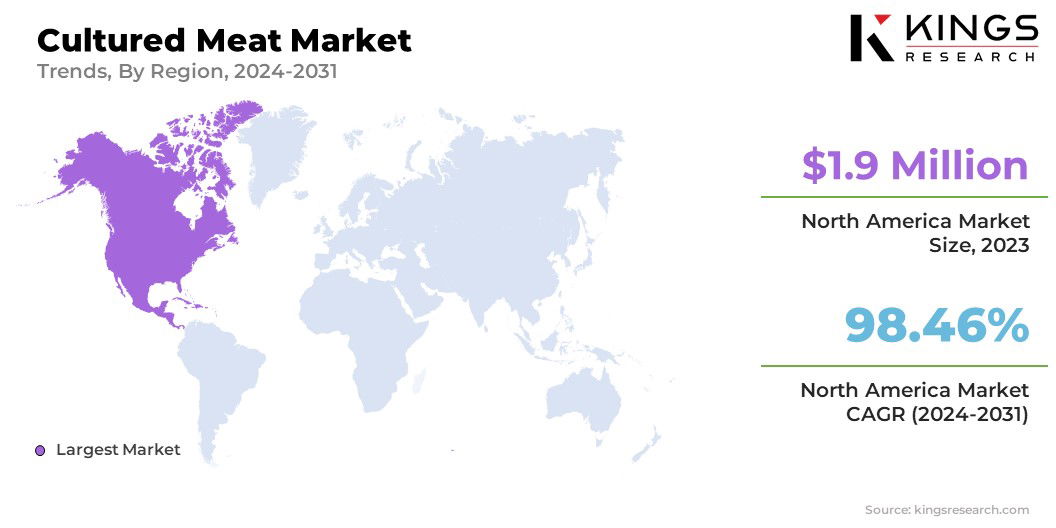Food and Beverages

Cultured Meat Market

Cultured Meat Market Size, Share, Growth & Industry Analysis, By Source (Poultry, Beef, Pork, Seafood, Others), By End-Use (Nuggets, Burgers, Meatballs & Sausages, Others) and Regional Analysis, 2024-2031
Pages : 120
Base Year : 2023
Release : May 2024
Report ID: KR715
Cultured Meat Market size
Global Cultured Meat Market size was recorded at USD 3.5 million in 2023, which is estimated to be at USD 6.8 million in 2024 and projected to reach USD 811.4 million by 2031, growing at a CAGR of 97.89% from 2024 to 2031. In the scope of work, the report includes solutions offered by companies such as Aleph Farms, Believer Meats, BlueNalu, Eat Just, Inc., Finless Foods, Inc., Meatable, Mosa Meat, SuperMeat, UPSIDE Foods, Wildtype, and others.
The growth of the market is primarily driven by increasing concerns regarding environmental sustainability and animal welfare. Consumers have become more aware of the environmental impact of traditional meat production methods, and thus, seek eco-friendly alternatives. Additionally, the growing global population and the need for sustainable food production are driving the demand for cultured meat. Moreover, advancements in biotechnology and food technology are making cultured meat more accessible and cost-effective, thereby fueling market growth.
The cultured meat market is emerging as a promising segment within the food industry, characterized by rapid innovation and increasing consumer interest. Major food corporations are investing heavily in this sector, anticipating a significant shift in dietary preferences toward sustainable and ethical alternatives. The market is expected to witness substantial growth in the forthcoming years, mainly driven by favorable regulatory developments and growing consumer acceptance of alternative proteins.
Cultured meat, also referred to as lab-grown meat or cell-based meat, is an alternative to traditional meat derived from livestock. It is produced by culturing animal cells in a controlled environment, without the need for raising and slaughtering animals. This innovative approach to meat production offers numerous benefits, including reduced environmental impact, animal welfare improvements, and potential health advantages.
Cultured meat is anticipated to transform the global food industry by providing a sustainable and ethical solution to meet the growing demand for protein sources while addressing the challenges associated with conventional meat production.

Analyst’s Review
Manufacturers in the cultured meat market are actively innovating to meet surging consumer demands. These efforts include improvement in taste and texture, expansion of product lines, and enhancement in sustainable scale-up of cell culture processes. New products such as cultured meat burgers and sausages are gaining significant traction in the market.
However, regulatory complexities and challenges associated with production scalability may hamper widespread adoption. However, the market is likely to display robust growth, driven by technological advancements and shifting consumer preferences toward sustainable and ethical food options.
Cultured Meat Market Growth Factors
The increasing consumer awareness and rising demand for sustainable and ethical food options are significant factors supporting the expansion of the cultured meat market. Consumers are actively seeking alternatives to traditional meat due to rising concerns regarding environmental impact and animal welfare. This growing awareness is prompting companies to invest heavily in research and development, leading to technological advancements and cost reductions in cultured meat production.
The market is experiencing steady growth as more consumers recognize the benefits of cultured meat in addressing key sustainability and ethical concerns in the food industry. The regulatory uncertainties and the need for clear guidelines and approval processes are key challenges impeding industry progress. To address these challenges, industry stakeholders are actively engaging with regulatory authorities to establish robust frameworks governing the production and labeling of cultured meat products.
Collaborative efforts between industry leaders, policymakers, and regulatory bodies are supporting the development of standardized protocols aimed at ensuring the safety, quality, and transparency of cultured meat products. Clear regulations are boosting consumer confidence and facilitating market entry for new products that is fostering the growth of the cultured meat sector.
Cultured Meat Market Trends
The increasing focus on product innovation and diversification is a key trend prompting companies to continuously explore new techniques and technologies to enhance the taste, texture, and nutritional profile of cultured meat products. This trend is further driven by growing consumer preferences for meat alternatives that closely mimic the sensory experience of conventional meat.
This results in an improvement in cell culture methods and the incorporation of plant-based ingredients for flavor enhancement. Thus, innovation in the industry is resulting in the development of cultured meat products that cater to diverse consumer preferences and dietary needs. Industry participants are undertaking partnerships and collaborations across the value chain, including forming strategic alliances with research institutions, biotechnology firms, and food industry stakeholders, to accelerate the development and commercialization of cultured meat products.
These partnerships enable knowledge sharing, access to resources, and shared expertise in overcoming technical challenges and scaling production. Collaborative efforts are further facilitating market entry, regulatory compliance, and consumer acceptance of cultured meat. This evolution of the industry is highlighting the vital role of collaborative initiatives in fostering innovation and propelling the cultured meat market growth.
Segmentation Analysis
The global market is segmented based on source, end-use, and geography.
By Source
Based on source, the market is segmented into poultry, beef, pork, seafood, and others. The poultry segment led the cultured meat market in 2023, reaching a valuation of USD 1.3 million. The segment is experiencing significant expansion due to rising demand for poultry cultured meat, growing concerns about environmental sustainability and animal welfare compared to traditional poultry farming.
Furthermore, advancements in cellular agriculture technologies increase the feasibility and cost-effectiveness of producing cultured poultry meat on a large scale. Additionally, surging consumer demand for healthier and more sustainable protein sources is contributing significantly to segmental growth, with poultry cultured meat serving as a viable alternative.
By End-Use
Based on end-use, the cultured meat market is classified into nuggets, burgers, meatballs & sausages, and others. The nuggets segment secured the largest revenue share of 37.89% in 2023. The expansion of the segment can be attributed to its surging popularity. Nuggets are a familiar and widely consumed food item, making them a highly preferred choice for introducing cultured meat to consumers.
Moreover, the convenience and versatility of nuggets appeal to a broad range of consumers, including children and busy adults. Furthermore, ongoing efforts by companies to improve the taste, texture, and nutritional profile of cultured meat nuggets are contributing to the growth of the segment.
Cultured Meat Market Regional Analysis
Based on region, the global market is classified into North America, Europe, Asia Pacific, MEA, and Latin America.

The North America Cultured Meat Market share stood around 54.29% in 2023 in the global market, with a valuation of USD 1.9 million. This dominance is attributed to several factors, notably a strong consumer base characterized by increasing awareness, along with a growing demand for plant-based and cultured meat alternatives.
This demand is further driven by rising health and sustainability concerns, prompting North American companies to focus on innovation and investment in cultured meat technologies. Additionally, favorable regulatory frameworks and supportive government initiatives are supporting regional market development.
The Asia-Pacific is anticipated to expand at a CAGR of 97.89% over the forecast period. This rapid growth is primarily bolstered by the growing middle-class population with increasing purchasing power. Moreover, ongoing advancements in technology and digitalization are fostering innovation and productivity, creating a favorable environment for economic expansion.
Additionally, supportive government policies and substantial investments in infrastructure are contributing significantly to regional market growth, attracting investments from domestic and international players.
Competitive Landscape
The cultured meat market report will provide valuable insight with an emphasis on the moderately consolidated nature of the industry. Prominent players are focusing on several key business strategies such as partnerships, mergers and acquisitions, product innovations, and joint ventures to expand their product portfolio and increase their market shares across different regions.
Manufacturers are adopting a range of strategic initiatives, including investments in R&D activities, the establishment of new manufacturing facilities, and supply chain optimization, to strengthen their market standing.
List of Key Companies in Cultured Meat Market
- Aleph Farms
- Believer Meats
- BlueNalu
- Eat Just, Inc.
- Finless Foods, Inc.
- Meatable
- Mosa Meat
- SuperMeat
- UPSIDE Foods
- Wildtype
Key Industry Developments
- November 2023 (Partnership): Meatable inaugurated a 3300 square meter facility at the Bio Science Park in Leiden, the Netherlands, doubling its previous space to enhance cultivated pork development. The expanded facility includes larger bioreactors (50L to 200L, later 500L), facilitating increased production and testing of cultivated pork. This development follows Meatable’s $35M Series B funding and signifies progress toward commercializing its products, with plans for a 2024 launch in Singapore.
- October 2023 (Partnership): BlueNalu entered into strategic partnerships with major seafood industry leaders in the Asia-Pacific region, including Mitsubishi Corporation, Pulmuone Co. Ltd., and Thai Union, to support its planned launch of cell-cultured seafood in several APAC nations. These collaborations focus on market insights, regulatory compliance, and go-to-market strategies, with the aim of understanding consumer preferences, streamlining approvals, and developing effective distribution channels for BlueNalu's products across the region.
The Global Cultured Meat Market is Segmented as:
By Source
- Poultry
- Beef
- Pork
- Seafood
- Others
By End-Use
- Nuggets
- Burgers
- Meatballs & Sausages
- Others
By Region
- North America
- U.S.
- Canada
- Mexico
- Europe
- France
- U.K.
- Spain
- Germany
- Italy
- Russia
- Rest of Europe
- Asia-Pacific
- China
- Japan
- India
- South Korea
- Rest of Asia-Pacific
- Middle East & Africa
- GCC
- North Africa
- South Africa
- Rest of Middle East & Africa
- Latin America
- Brazil
- Argentina
- Rest of Latin America
CHOOSE LICENCE TYPE
CUSTOMIZATION OFFERED
Additional Company Profiles
Additional Countries
Cross Segment Analysis
Regional Market Dynamics
Country-Level Trend Analysis
Competitive Landscape Customization
Extended Forecast Years
Historical Data Up to 5 Years
